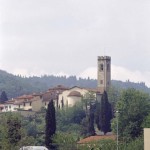San Martino a Gangalandi was, in 1986, the first museum of sacred art established in the Florentine district in a synergic collaboration with the State, church authorities, and the Ente Cassa di Risparmio di Firenze, which financed the project.
Adjoining the church, the building is set against the imposing bell-tower and used to be the seat of the Societas Beatae Virginis Mariae Communis Gangalandi, founded in the 13th or beginning of the 14th century, following the intense reformation movement set in motion in Florence by Saint Peter Martyr (Verona 1205-Seveso 1252) of the Dominican Order. He was a tireless advocate of the Catholic religion against the Cathar heresy. During his stay in Florence in the Convent of Santa Maria Novella, he founded in 1244 what today is the Venerable Archconfraternity of the Misericordia of Florence, the first of its kind.
The building has been reorganized according to the new exhibition needs. Works from both the Church of San Martino and its suffragan churches are found on the two floors.
The painting by Lorenzo Monaco depicting the Madonna of Humility from the first decade of the 15th century is among the museum’s most noteworthy works.
Next to it is a triptych attributed to Lorenzo di Bicci (documented in Florence, 1370-1409) and to his son Bicci di Lorenzo (Florence 1368 –Arezzo 1452), outstanding artists in Florence during the first decade of the Renaissance.








